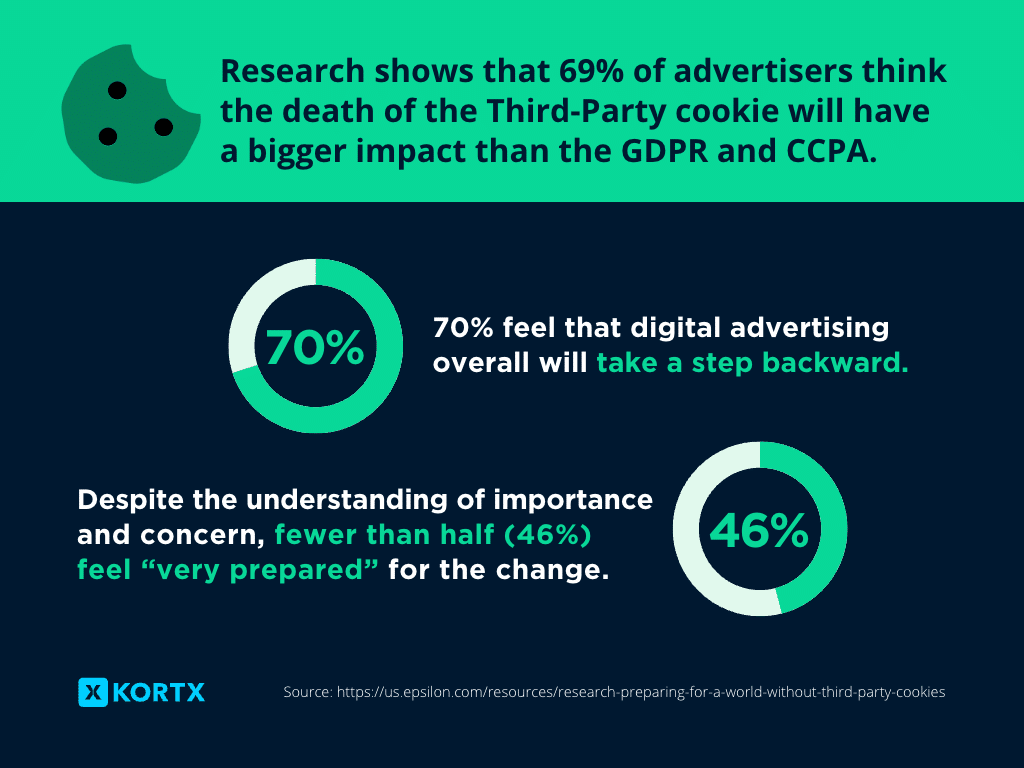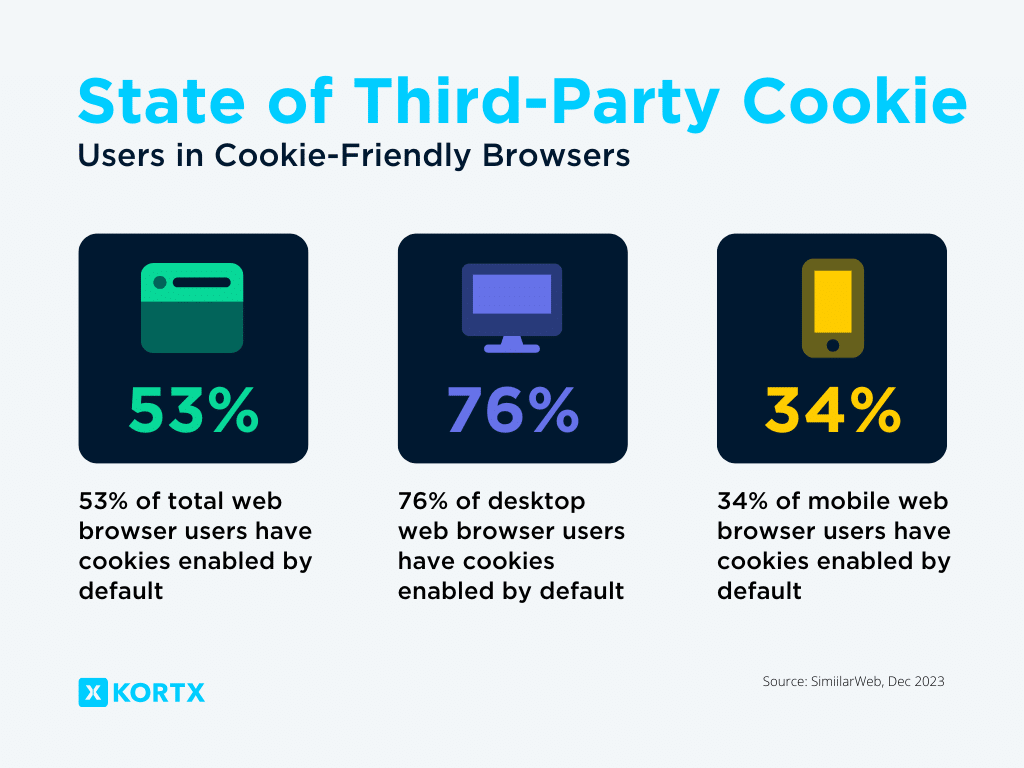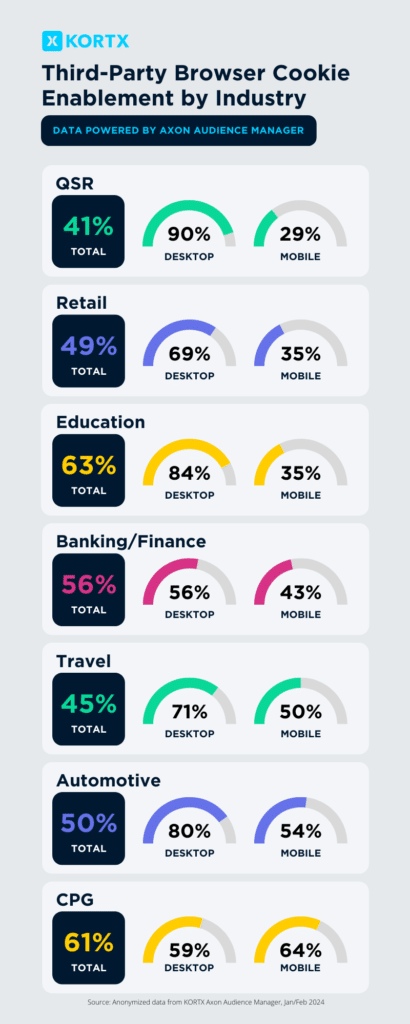Experiences refined for people
Experiences refined for people
By the end of 2024, all cookies will be deprecated in Google Chrome. Just over 50% of internet browser users currently have cookies enabled.
Now is the time to act.
In 2020, Google set the digital marketing world abuzz by announcing that it would stop allowing Third-Party cookies in its market-share-winning browser, Chrome.
Biding your time on this change has been easy when Google seems prepared to do the same. Since the original announcement, the tech giant has delayed this change twice, first by a year and then two.
The phase-out of cookies has reshaped advertising spend, pushing programmatic advertisers to prioritize First-Party data and invest in private ecosystems. As a result, open exchanges are expected to hold less than 10% market share by the end of 2024.
Why haven’t more advertisers made to jump to test 3P free solutions?
“As advertisers, we’ve been blessed (and perhaps cursed) with endless taxonomies, metrics, and tracking options. With this wealth of data, there have been years of fine-tuning to attract and convert new customers and, maybe more importantly, defend market share. Given the pressure on CMOs for short-term return on investment, diverting funds from proven initiatives to test for the uncertain future is an increasingly difficult decision to stamp their name on. Especially knowing the average tenure of CMOs is just 40 months.”

Continuing to rely entirely on Third-Party cookies and targeting is not a sound strategic approach for digital marketers in 2024. With so many emerging technology options and channels to engage with audiences, moving beyond 3P targeting is a must to stay competitive. Many of the largest growing channels (CTV, for example) are Third-Party cookie-free.
Your customers are not going anywhere, but over the next 6 months, you will need to develop new ways to reach them. Testing solutions like 1P data and contextual marketing will be the best move for your team.
✨ If anyone is telling you they have a definite solution, proceed cautiously. Remember, the reality is Google doesn’t know where this is going, and they started the whole process.
Continue reading our Guide to a Cookieless Marketing Future to learn:

The digital landscape has changed significantly since the original announcement from Google. More and more web users are already browsing in a cookie-free browser. While Google has cornered desktop browsing, Safari’s is now the most popular mobile browser. Apple set the browsing default to block Third-Party tracking 3 years ago.
This article will cover the percentage of users already surfing on browsers that block 3P cookies by default (including industry-specific stats) and what you can do to start marketing without Third-Party cookie reliance today.
A cookie is a snippet of text code placed in a browser that enables a website or third party to track a user’s movements and activity on a specific site or across the web. There are two main types of cookies: First-Party Cookies and Third-Party Cookies.
🍪 What is a First-Party cookie?
An individual website creates a First-Party (or 1P) cookie. These cookies are necessary to track personal preferences and sessions. This type of cookie is essential to a functioning website as it provides a personalized user experience through saving login credentials, website efficiency, eCommerce capabilities, and data/form entry saves.
🍪 What are Third-Party cookies?
Advertisers create Third-Party (or 3P) cookies to track user habits and actions on a website. Browsers (such as Google Chrome and Safari) can ban these cookies. These cookies have a bad reputation as they do not require user permission to collect data. 3P cookies are difficult to understand, enabling fingerprinting of users across multiple websites. This fact has led to poor consumer perception and a lack of regulation.
While many marketers have succumbed to the temptation of waiting to tackle the cookie-free question, many customers and users are already functioning in a cookie-free digital environment, especially those who spend most of their time using mobile devices to browse the web.
Despite Google pushing back cookie deprecation, many users already browse in a cookieless world. The ability to track a user through Third-Party cookies depends on what browser they are currently using. While Google Chrome technically has the most significant current marketing share (45.24% in the US as of December 2022), there is a chance a substantial number of your customers are already cookie-free by default or have made a choice to do so.
Browsers & Third-Party Cookie Settings
🟡 Chrome: Allows Cookies by default, 1% of users currently have cookies toggled off by default
✅ Edge: Allows Cookies by default
✅ Opera: Allows Cookies by default
✅ Samsung Internet: Allows Cookies by default
❌ Safari: Blocks Cookies by default
❌ Firefox: Cookies allowed on the initial site, banned otherwise.
Note: The following data showcases which browsers currently allow and default to cookies compared to those that have either banned the use or defaulted not to accept cookies. Single-user settings may impact this data, but the following provides a decent benchmark for tracking in 2024.

Whether or not most of your users browse in a cookie-friendly fashion depends on your industry’s core audience and internet habits. Some industries (like B2B companies) have users who browse more often on a desktop, leading to a more significant percentage of cookie-friendly interactions. Other audiences, comprised of primarily mobile browsers, are less likely to interact with your content while having cookies enabled.
Note: Like the browser share above, the following numbers showcase the percentage of users on cookie-friendly browsers. It does not account for users who have chosen to toggle cookies on or off. All data is pulled anonymously from KORTX’s Axon Audience Manager.

Are my customers browsing a cookie-free internet?
Using your website’s data is the best way to determine whether or not your customers have moved on from a cookie-friendly browser. Check marketing analytics platforms like Axon or Google Analytics to find this data.
KORTX’s team of marketing analysts can help you determine if cookie-free marketing tests should be a priority. Plus, ask us about a free Axon Audience Manager trial.
Customers are mobile-first and cookieless in 2024. Brands marketing to a mobile-heavy audience should identify alternatives to Third-Party targeting immediately to combat audience data depreciation.
Digging deeper, our industry-specific data uncovered that:
What do brands miss by relying on Third-Party cookies?
“Relying solely on Third-Party targeting can mean missing entire audiences that would otherwise engage with your brand, and indicates a lack of readiness to evolve audience-centric targeting strategies. The tremendous advancements in programmatic advertising have downplayed the value of market research and audience strategy. Now, is the time for marketers to revisit these key concepts as the convenience of behavioral advertising shifts.”

Marketers relying heavily on mobile ad IDs (MAIDs) already feel the impact of targeting and attribution changes. Brands unprepared for cookie deprecation will be at a disadvantage as they rush to test and catch up to competitors. However, the shift in audience strategy can be turned into an opportunity for brands and agencies. For all of the benefits that programmatic advertising and 3P data have brought for marketers, it has also caused many marketers to miss out on audience opportunities.
Marketers hoping to reach their customers must take an audience-based approach when planning campaigns. Rather than focusing on shiny objects and new tactics, consider your audience, where to find them, and how best to market to them first.
Starting with consumer research, the core audience you’d like to target, or other First-Party data can help you discover where to find customers. Once you understand how your core customers interact with digital marketing placements and where to find them, the placement tactics and creative messaging will be easier to pinpoint (and ultimately more efficient).
Cookie-based audience targeting is still an option, but marketers need to have a plan to address an alternative targeting approach – we dive into those below.
Agencies and marketing teams should start exploring and testing cookieless solutions sooner rather than later. Your team may be missing up to half of their marketing prospects’ data by relying entirely or mostly on 3P data. No one solution applies to all use cases, brands, or campaigns. Instead, we recommend beginning with relevant tests against core campaigns and business goals to determine best practices for the future.
How can a business determine the best tactic for marketing in the cookieless marketing landscape?
“You need to figure out what you’ll lose and replace it. The best tactics will replenish, enhance, or replace the current solution once cookies are ineffectual. Advertisers should audit their current digital marketing structure and cookies’ role in its execution. Identifying the impact of cookie deprecation specific to your marketing strategy enables a more systematic approach to evaluating cookieless solutions.”

ID-free solutions allow brands to combine their First-Party data with AI to discover audience behavioral patterns. ID-free is a privacy-focused behavioral targeting solution without Third-Party cookies.
It uses neural network technology to analyze anonymous digital journey patterns and create a map to identify similar website visitors’ actions. Advertisers can customize their model using owned First-Party data to predict and select impression opportunities.
🍹 Case Study: Tropical Smoothie Cafe ID-Free Targeting
Targeting Goal: Tropical Smoothie Cafe wanted to raise brand awareness and attract new customers using digital advertising. KORTX partnered with Dstillery and set a goal to reduce their cost per acquisition (CPA) for display and video advertising.
Our Strategic Approach: KORTX utilized Dstillery’s ID-free Custom AI audiences, a cookieless targeting solution, to target prospective customers. We used the client’s first-party data gathered from pixel placement on their website through Axon Audience Manager, which allowed us to target people who had shown interest in the brand.
Campaign Results: The ID-free Custom AI audiences reduced the client’s display CPA by -70% and video CPA by -75% compared to Third-Party QSR segments and contextual competitors.
Finding the right contextual audience can help you locate customers interested in your products and solutions without Third-Party data. In this case, contextual marketing allows brands to advertise and message based on the page a user lands on or based on data gathered by an AI.
What is contextual marketing?
A particular blog post, website, or other web property quickly provides context for a customer’s interest. For example, a customer browsing information about developmental milestones for a toddler is likely a parent or caregiver and is probably interested in a toy brand.
In addition to using traditional contextual marketing, AI contextual marketing offers a new, cookie-free option for campaigns. AI-powered contextual marketing uses real-time analysis of audience actions to understand contextual signals that drive interest and awareness. The AI detects successful engagement moments and captures them to target similar content to new audiences in similar moments, allowing brands to engage with the right people at the right time. Advanced contextual marketing does not use cookies or personal data, making it privacy-friendly and compliant with GDPR/CCPA.
🩺 Case Study: Pharmaceutical Company’s HIPAA-Compliant Audience Discovery
Targeting Goal: A national pharmaceutical company aimed to increase awareness and reach potential customers while adhering to HIPAA regulations.
Our Strategic Approach: To ensure HIPAA compliance and avoid cookie-based targeting, KORTX utilized its KORTX Intelligence Audience Discovery process to identify unique traits of consumers engaging with medical issue-related content across the open web. The strategy focused on contextual targeting to align the brand’s messaging with healthcare-related websites.
Campaign Results: The campaign exceeded the client’s goals with a CTR of 0.35%, surpassing industry benchmarks by over 2.5x. The CPC was $1, and the campaign garnered 13M impressions and 46K clicks.
Brands can use Second-Party data for audience targeting by leveraging deterministic identification processes. Data is collected and matched using login IDs or device information rather than relying on browser cookies or mobile IDs. Using Second-Party data from trusted partners allows advertisers to identify and target specific audience segments.
At KORTX, we partner with Xandr to use a deterministic ID process that doesn’t require cookies or mobile IDFA. Xandr targets audience segments at the user and household level, making them unaffected by cookie deprecation and a scalable and accurate audience targeting methodology.
🛋 Case Study: Furniture Retailer’s Cross-Device Audience Targeting Strategy
Targeting Goal: NFM aimed to supplement their linear ad buys and reach cord-cutters and cord-nevers through a CTV campaign while tracking consumer engagement across devices.
Our Strategic Approach: KORTX used the Axon platform to capture First-party consumer touchpoints and build niche audiences. KORTX then leveraged Xandr’s curated audience segments (Second-Party), built on millions of AT&T consumer touchpoints, including mobile location, internet browsing, and TV viewership, to augment the brand’s linear buy. The strategy tracked consumer engagement across devices and measured the impact of CTV on website activity.
Results: The campaign increased online sales and site traffic through CTV ad dollars.
Data is crucial in a world without P cookies. Media Mix Modeling (MMM) and media experiments can fill the data gap left behind by cookie deprecation. MMM evaluates the effectiveness of different marketing channels to optimize budget allocation. Meanwhile, media experiments, through testing hypotheses, yield insights from real-world scenarios. This approach delivers valuable data that shapes strategic choices and directs marketing spending without needing personally identifiable information (PII) or cookies.
Dynamic and trigger-based creativity allows brands to customize messages using accessible attributes without depending on Third-Party cookies. Factors such as weather, time of day, day of the week, and specific rules facilitate highly personalized advertising experiences.
Testing new solutions is just step one for preparing for Third-Party cookie deprecation. The following strategies will help position you for a cookieless future and improve your day-to-day attribution and data collection.
Allocate additional budget to testing data segments to gather insights about which audiences are driving success. Apply these insights to your current and future marketing endeavors.
Every site visitor offers value. Finding the right audience management platform is imperative for creating a robust and helpful First-Party data strategy. First-Party data helps marketers understand variables such as vistor source (social media, organic search, etc.), campaign exposure, site actions, and dozens of other data points.
KORTX uses our audience manager, Axon, to help our clients gather First-Party data and insights.

Our customized research and insights will reveal opportunities you never knew existed. With KORTX Intelligence, you can unlock your brand’s full potential and take your digital advertising strategy to the next level.
Many attributes of your target audience can be identified and applied to future campaign strategies instead of Third-Party data, including device usage, day-part patterns, preferred social media channels, geographic location, along with many others. Combining these audience attributes helps paint a clear picture of the target audience from several dimensions.
The value of UTM codes goes beyond simply tracking a site visitor’s source or campaign performance. Within the functionality of an audience management platform, UTM values serve as events to construct First-Party data segments and elevate retargeting to a higher level of sophistication.
Site architecture and content change often, but the tags and pixels that enable retargeting, tracking, and measurement could be misaligned. To get the most value out of 1P data, audit your site’s tagging structure to ensure that all relevant events are accurately tracked and captured.
An increasing number of users are surfing on browsers that block Third-Party cookies by default, making it crucial for marketers to start testing and acting now to prepare for a cookieless future. Dive into your data and discover how many of your customers are already on a browser that blocks cookies by default.
Our expert team can help you identify the best tactics for your brand or client. Includes cookieless options like:
About the Author
Corey Rice is Director of Strategy at KORTX and has nearly 18 years of digital marketing experience. Prior to joining KORTX, he worked at agencies, publishers, and tech companies in San Francisco and Detroit.
From us to your inbox weekly.